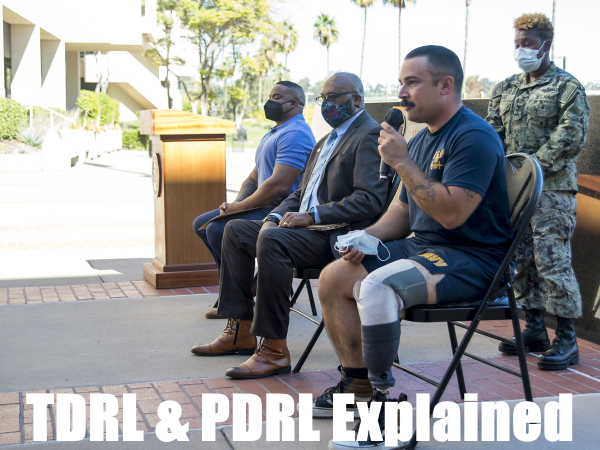Veterans who are eligible for disability retirement receive different classifications, like TDRL and PDRL.
It’s important to understand the difference between the Temporary Disability Retirement List (TDRL) and Permanent Disability Retirement List (PDRL).
Understanding the difference enables former service members to determine what military benefits they qualify for upon retirement.
As a result, continue reading to learn more about TDRL and PDRL retirement.
Related Article – 10 Best Military Retirement Gifts
Table of Contents
TDRL & PDRL Explained

What happens when you leave service with a serious injury or disability?
In general, the military considers various types of disability when selecting an appropriate discharge.
That’s because the type of disability rating a service member receives determines the appropriate pension and benefits.
So, it’s crucial to know the difference between the Permanent Disability Retired List (PDRL) and the Temporary Disability Retired List (TDRL).
In most situations, when a service member is unable to return to duty, they are evaluated prior to discharge.
The Defense Accounting and Finance Service (more details, below) manages discharges involving disability.
Accordingly, one of the goals of the department is to determine a disability rating: TDRL or PDRL.
The Disability Evaluation System (DES) was created to determine what disability rating the veteran qualifies under.
For this reason, those that have a condition that may improve are generally placed under TDRL status.
Meanwhile, others end up on the Permanent Disability Retirement List (PDRL) because the condition prevents them from performing their military duty.
Veterans who are eligible for TDRL or PDRL receive disability retirement directly from the Department of Defense, not Veterans Affairs (VA).
Therefore, the qualifications for a disability rating and what it implies are different from VA guidelines.
The Disability Evaluation System (DES)
The Defense Accounting and Finance Service (DFAS) handles military discharges related to a disability.
For this reason, the department conducts an evaluation to determine a disability rating: A) TDRL or B) PDRL.
The Disability Evaluation System (DES) is designed to produce consistent decisions on medical rulings.
So, in situations where a service member is unable to return to duty, they are evaluated for disability status.
Often, individuals who have a condition that is currently preventing them from performing a duty are placed on the Temporary Disability Retired List (TDRL).
Meanwhile, service members who cannot fulfill their duty and are not expected to recover sufficiently are placed on the Permanent Disability Retired List (PDRL).
Third, DFAS has the discretion not to award any type of disability status.
Therefore, not everyone who undergoes a Disability Evaluation System evaluation is approved for TDRL or PDRL.
Regardless of the disability rating, both classifications are considered “retired lists.” This means they are reserved for individuals who intend to retire from service.
There are numerous benefits to receiving a TDRL or PDRL rating (more information, below).
Qualifying for Disability Retirement (TDRL & PDRL)
When a service member gets injured or sick, they may require routine care.
Then, if the condition does not improve, an evaluation may be necessary to determine if the individual is fit for service.
Those that are unlikely for returning to duty are usually evaluated for a disability rating.
The determination is necessary for assigning what types of military benefits and medical care the individual qualifies for.
As a result, there are substantial differences between TDRL and PDRL.
DFAS Disability Rating (Disability Percentage)
Veterans who are classified as temporarily or permanently disabled by a military Physical Evaluation Board also receive a disability percentage.
The disability percentage, according to DFAS, helps determine “whether [the service member’s] disability qualifies for retirement or separation.”
Accordingly, the guidelines for DFAS disability rating are as follows:
- Disability Existed Prior to Service = Recommended for Discharge with Benefits
- Disability Rating 30% or Lower = Separation Without Retirement Pay
- Disability Rating 30% or Higher / Less than 20 Years of Active Service = Retirement Pay & Military Benefits
- 20+ Years of Active Service = Retirement Recommended (regardless of disability rating)
Furthermore, situations do occur where a military retiree is transferred from TDRL to PDRL, or vice versa.
Accordingly, the 30% or higher rule is generally applied to any circumstance, even conditions that get worse over time.
Related Article – Military Medical Separation & Retirement
Military Disability Retirement
The Department of Defense refers to disability retirement as “Chapter 61 retirement“.
It’s governed by U.S. statutes that determine disability rating for service members unfit for duty.
Therefore, the law specifically states that:
- A service member whose condition is not stable may be placed on the Temporary Disability Retired List (TDRL) for up to 5 years at which point they must be either A) discharged, B) retired, or C) returned to duty.
- Meanwhile, service members with a condition that has stabilized at a disability rating of 30% or higher are placed on the Permanent Disability Retired List (PDRL).
Then, once the Department of Defense determines a disability status, the DoD awards retirement pay based on a few factors.
Military Disability Pay
Any veteran placed on the Permanent Disability Retired List (PDRL) may receive retirement pay.
Therefore, the amount of the disability pay is calculated in one of these methods:
- Disability Percentage, or Method A
- Years of Active Service, or Method B
The military selects the method that is more beneficial to you or, in other words, the method which awards a higher payout.
Those who are switched from PDRL to TDRL also have their retirement pay recalculated as a result.
Thus, pay is always dictated by the most current disability rating by base pay of military rank (Disability Rating % x Retired Pay Base).
Military retirees under TDRL status may also be entitled to retirement pay (depending on years of service) yet it is calculated at a lower percentage compared to PDRL.
Additionally, military retirees may qualify for other special types of retirement pay, including Combat-Related Special Compensation and Concurrent Retirement and Disability Pay.
Temporary Disability Retired List (TDRL)
When a service member is placed on TDRL, they have 3-5 years to recover from the condition.
The military evaluates each service member placed on the Temporary Disability Retired List to see if the condition improves or declines.
Those that improve may be completely removed from TDRL as well as returned to duty.
Meanwhile, others with a condition that fails to improve may either be forced to retire or upgraded to the Permanent Disability Retired List.
It’s important to keep in mind that the Department of Defense evaluates service members for a disability differently compared to Veterans Affairs (VA).
While the VA is invested in the injury or condition, the DoD only determines a disability based on whether the individual is able to perform their duties or not.
Thus, service members are frequently evaluated (at least once every 18 months) while assigned to TDRL.
Nonetheless, service members do earn disability pay while under this status, which is calculated at 50% minimum.
Finally, the DoD recently updated its guidelines for TDRL.
As a result, any service member who is assigned TDRL status on or after January 1, 2017 may only remain on the temporary retired list for up to 3 years.
Nevertheless, the same rules apply. At 30% or higher, the service member will be transferred to PDRL.
Those with less than 30% and less than 20 years of service do not qualify for PDRL but are still entitled to severance pay.
Permanent Disability Retired List (PDRL)
The second disability classification utilized by the Department of Defense is PDRL.
Service members with a disability rating of 30% or higher qualify for the Permanent Disability Retired List.
Moreover, any service member with 20 or more years of service also qualifies for the retired list, regardless of the disability percentage.
Once again, the retirement pay is determined by Method A or Method B, whichever is more beneficial to the service member.
Those that are transferred from TDRL to PDRL also have their retirement pay recalculated as a result (and for the better!).
Related Article – 300+ Military Separation Codes And Their Meanings
TDRL & PDRL Military Benefits
The Department of Defense reserves TDRL and PDRL classification for military retirees.
And, despite the many differences between the 2 classifications, both award many of the same benefits and privileges.
For example, military retirees receive ID cards, which are loaded with perks like access to hundreds of military discounts.
However, it’s important for those on TDRL to remember that the benefits are not permanent.
Rather, they disappear as soon as the conditions are no longer required to support disability pay and benefits.
It usually occurs because A) the person on TDRL is no longer declared “disabled,” or B) the status was transferred to PDRL.
Meanwhile, other benefits of military disability retired lists include participation in Survivor Benefit Plans and access to VA loans.
The Department of Defense can assist with additional questions or concerns.
TDRL & PDRL Frequently Asked Questions (FAQs)
Do you need help understanding TDRL or PDRL?
Here are some frequently asked questions:
What do TDRL and PDRL mean in the military?
The Temporary Disability Retired List (TDRL) is not permanent.
The disability rating is consistently evaluated over 3-5 years until it’s determined that: A) the service member can return to duty, or B) needs to transfer to PDRL.
Nevertheless, military benefits like special compensation are provided while under the status.
Meanwhile, service members with a condition that prevents them from returning to duty are placed on the Permanent Disability Retired List (PDRL).
How is the disability rating determined?
The Defense Accounting and Finance Service (DFAS) manages medical evaluations.
The DES evaluation determines a disability percentage between 0 and 100%.
Then, the disability percentage (along with years of service) indicates whether the service member qualifies for TDRL or PDRL.
The disability rating is crucial to determining the amount of retirement pay.
How much do TDRL and PDRL pay?
The retirement pay is calculated depending on a few factors.
First, the disability percentage is multiplied by base pay.
Secondly, the amount of retirement pay is dictated by years of service.
Therefore, the longer you served and the higher the disability rating percentage, the more the payout.
Can TDRL or PDRL change?
Yes, the military frequently evaluates individuals, especially those placed on the Temporary Disability Retired List (TDRL).
In general, evaluations are mandatory every 18 months, and individuals who fail to show up are immediately removed from the list.
Accordingly, any reexamination that determines that the disability has stabilized may drop or upgrade you from TDRL.
Conclusion
It’s important to know the difference between TDRL and PDRL.
The Temporary Disability Retirement List is not permanent and has required evaluations every 18 months.
In general, service members may remain on the list for 3-5 years before getting removed from TDRL or upgraded to PDRL.
The Permanent Disability Retirement List is reserved for conditions that prevent a service member from returning for duty.
Both types of disability retirement grant special pay and military benefits.
Featured Image Source – www.Flickr.com
- Replacing Dog Tags: 6 Things You Need to Know - June 28, 2024
- Navy OAR Test Study Guide - June 24, 2024
- 10 Best Sniper Movies of all Time - June 20, 2024
Originally posted on January 23, 2023 @ 11:32 pm
Affiliate Disclosure: This post may contain affiliate links. If you click and purchase, I may receive a small commission at no extra cost to you. I only recommend products I have personally vetted. Learn more.

